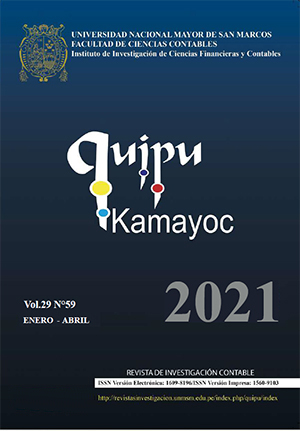Control of the National Superintendency of Customs and tax administration in tax works, 2019
DOI:
https://doi.org/10.15381/quipu.v29i59.20145Keywords:
tax benefit, public investment certificate, control, tax works, taxationAbstract
Objective: To contribute to the strengthening SUNAT’s tax administration control system in public investment projects that are executed in Peru through the mechanism of works for taxes. Method: The research was quantitative, has an explanatory and descriptive range, it is non-experimental, and possesses a cross-sectional and documental design. The sample was made up of 50 former SUNAT officials who, in November 2019, were surveyed on 16 items with an evaluative response of 5 alternatives. Results: The research’s results indicate that 80% of the participants fully agree with the implementation of a preventive, concurrent, and subsequent control; 20% agree, and 10% of them are indifferent to the matter; this resonates with the theoretical expectation. Conclusion: The proposal explains, by an average of 80%, that the perception of the 50 former SUNAT officials about the strengthening of the SUNAT’s control system with the implementation of a preventive, concurrent, and subsequent control, will strengthen the mechanism of works for taxes.
Downloads
Downloads
Published
Issue
Section
License
Copyright (c) 2021 Carmen Eufemia Ortiz Basauri

This work is licensed under a Creative Commons Attribution 4.0 International License.
AUTHORS RETAIN THEIR RIGHTS:
a. Authors retain their trade mark rights and patent, and also on any process or procedure described in the article.
b. Authors retain their right to share, copy, distribute, perform and publicly communicate their article (eg, to place their article in an institutional repository or publish it in a book), with an acknowledgment of its initial publication in Quipukamayoc .
c. Authors retain theirs right to make a subsequent publication of their work, to use the article or any part thereof (eg a compilation of his papers, lecture notes, thesis, or a book), always indicating the source of publication (the originator of the work, journal, volume, number and date).






